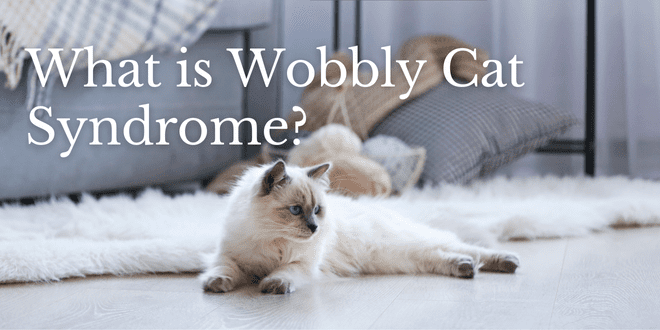What is Wobbly Cat Syndrome?
Cerebellar Hypoplasia (CH), also known as Wobbly Cat Syndrome, is a neurological condition where the cerebellum fails to develop and grow normally. The cerebellum is the part of the brain responsible for movement, balance, and coordination.
Causes of Cerebellar Hypoplasia in Cats
Cerebellar Hypoplasia is most commonly the result of a pregnant cat contracting the feline panleukopenia virus and passing it to her kittens in utero.
If a kitten has CH, it will be present at birth, but may not be noticeable until a couple of weeks old when the kitten begins to be more mobile. Kittens born with CH are not contagious.
Symptoms of Cerebellar Hypoplasia in Cats
- Wide stance
- Wobbling when standing or walking
- Swaying from side to side
- Jerking movements
- Head tremors
- Intention tremors (these happen when your cat is preparing for movement)
- Abnormal gait
- Having trouble changing positions
- Uncoordinated movements
CH is categorized as mild, moderate, or severe. Depending on the severity of the disorder, some kittens will only appear mildly uncoordinated or occasionally lose their balance but are still able to run and climb. More moderate levels of CH may cause kittens to stagger and sway when walking, and often have difficulty climbing.
Kittens with severe CH often fall over when attempting to walk. The level of severity determines how much extra assistance kittens need to eat, drink, and use the litter box.
This is a non-progressive disorder, so symptoms will not worsen as the cat grows.
How is Cerebellar Hypoplasia in Cats Diagnosed?
An MRI may be used for diagnosis, but many cases are diagnosed based on clinical signs. X-rays and blood tests are also performed to rule out other factors.
Treatment of Cerebellar Hypoplasia
There is no cure for CH as it’s the result of the brain failing to develop. Most kittens have normal lifespans. CH is not painful and is not contagious, so although severe cases may look as if a cat is hurting, they are not. Since affected kittens are born with CH, their level of coordination and mobility is all they’ve ever known.
Caring for a Cat with Cerebellar Hypoplasia
Set your cat up to succeed safely by providing a comfortable and easy way to navigate the environment. CH cats should be kept indoors and depending on severity, make sure they don’t have access to elevated areas or stairs that could result in injury. Use ramps (with good traction) to access safe elevated areas. Install baby gates at stairways as an added safety measure.
In many cases, wider food and water bowls will make it easier for your cat to eat and drink. In more moderate or severe cases, your assistance will be needed to ensure the cat gets enough food and stays hydrated.
If you have floors throughout your environment, use non-slip rugs or mats to provide extra traction and make it easier for a cat to balance.
Litter boxes will need to be uncovered and low-sided for ease of use. With a kitten, the use of a flat baking pan for a litter box may be easiest to navigate. As the kitten grows, you can usually graduate to a low-sided litter box, depending on your cat’s ability. Be tolerant and understanding of poorly aimed elimination attempts.
In a multicat household, be sure another cat doesn’t attempt to bully or push the CH cat away from resources. Watch how your other cats or dogs interact and play with your CH cat to ensure safety.
Cats with CH do well with other cats, but it’s important to set up the environment correctly, do a gradual and positive introduction, and monitor interaction.
Prevention of Cerebellar Hypoplasia
To prevent kittens from developing CH in utero, make sure cats are vaccinated. Panleukopenia is part of the core vaccine schedule. Don’t skip your cat’s vaccines.
Need More Information?
If you have questions about cerebellar hypoplasia, or any aspect of your cat’s health, consult your veterinarian. This article is not intended as a medical diagnosis and is not to be used as a replacement for your cat’s veterinary care.
For more information on cat behavior and training, refer to the best-selling books by Pam Johnson-Bennett. Books are available at your favorite bookstore and online. We have included links to Amazon here on our website.
 Problem Solving & Advice by Pam Johnson-Bennett Cat Behavior Expert & Best-selling Author
Problem Solving & Advice by Pam Johnson-Bennett Cat Behavior Expert & Best-selling Author




